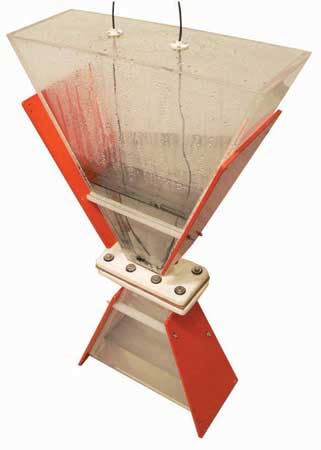 |
|
Art
and Science
II
|
||||||
|
The artworks of Marcus Ahlers (born 1974) functions on the borderline of visual arts and science. On one hand they explore visual metaphors for the human body in its surroundings, making reference to social and architectural space. On the other hand they are receptacles for electro-chemical reactions, which take place within them. The sculptures in Transposed nodes are made of everyday materials - often industrial in function. Some, such as X-electrolysis, are anthropomorphic in form. The upper torso-like area contains water and two wires which form the basis for an electrochemical process - electrolysis - which slowly divides the water molecules into hydrogen and oxygen. Ahlers notes that "everything is a series of electrochemical processes" which "connect us with our surroundings." In these works water electrolysis is not only a metaphor for the many electrochemical processes that are continually going on in our bodies on a cellular and molecular level. It also refers to the fact that our bodies are 70% water, and that water itself is made up of hydrogen, the basic element that makes up most of the matter in the universe, and oxygen which is necessary to life. Other recent works in the exhibition are architectural in form; though also indirectly anthropomorphic. As Ahlers' use of electrolysis refers to cellular and molecular functions, his use of architectural forms places the human in a social context. Buildings are our most immediate surroundings, which we not only inhabit, but move through, socialising, and breaking away into various public and private spheres. This movement through space, combining, separating and re-combining with others, is itself similar to a series of electrochemical reactions. Ahlers also makes reference to the anthropomorphic qualities of architecture, where the plumbing system mirrors the digestive tract and ventilation imitates respiration. The electrolytic reactions within these sculptures also produce inspiration and material for further works. Copper rods, representing pipes and plumbing react to electrolysis by producing a liquid copper pigment that Ahlers then uses in his drawings. In other works, crystals appear over the duration of the sculptures' lives, adding literally another layer, both aesthetic and chemical. The sculptures also produce oxygen and hydrogen. In fact water electrolysis is being considered as a means for producing hydrogen, an alternative and renewable energy source. In other projects, Ahlers has produced solar ovens and used bio-mass (in the form of 500 potatoes) to fuel a short wave radio. The artwork of Marcus Ahlers combines science and art to explore the inner connection between man and the environment on a variety of levels ranging from the molecular to the social to the global. Marcus
Ahlers is also one of the founders and leaders of the takt kunstprojektraum,
an art space and residency program based in Berlin-Friedrichshain. -Christian de Lutz |
|||||
| sponsored by: | ||||||||
 |
||||||||
 |
||||||||
